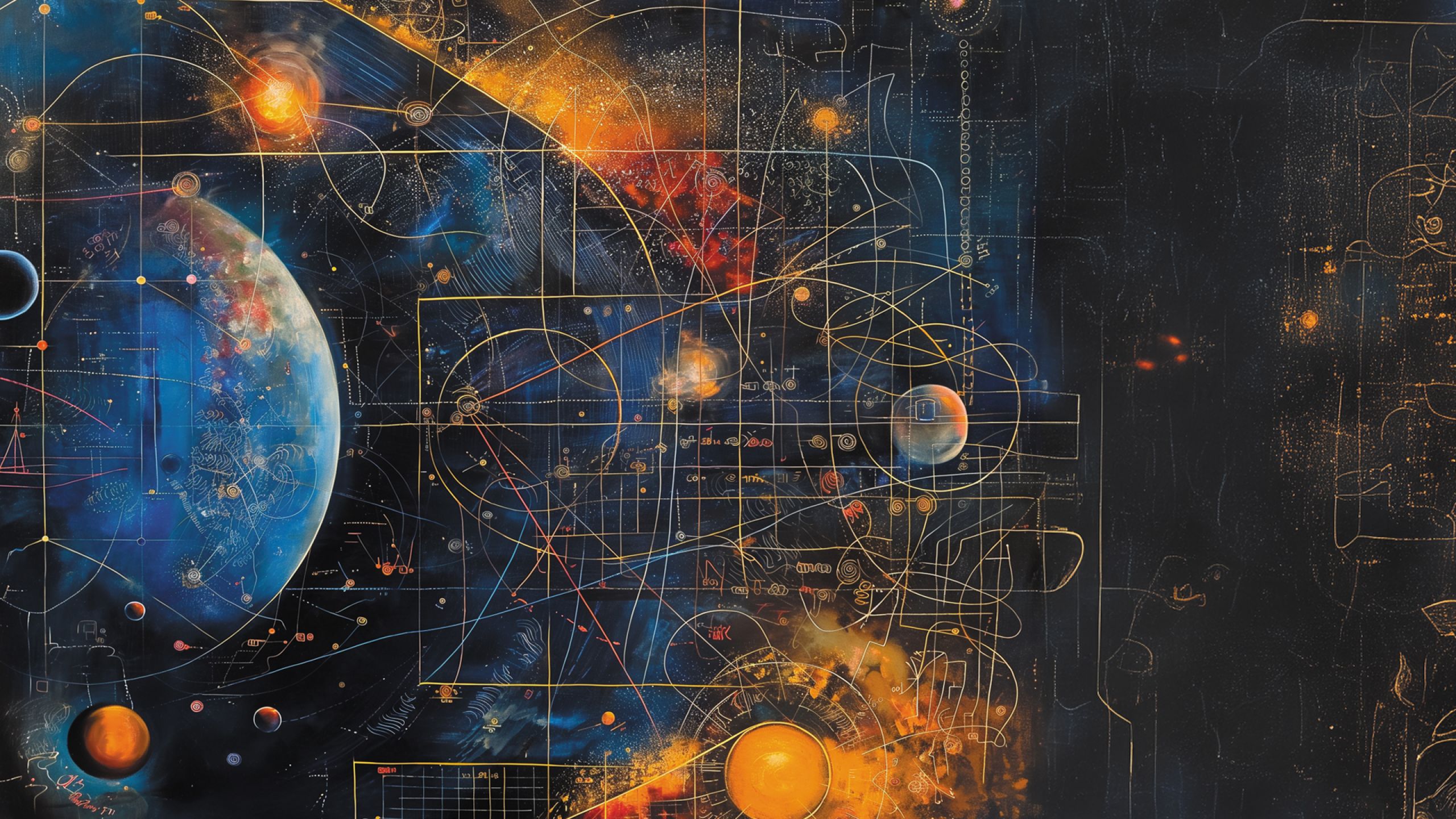Three Prisoners Seek Exoplanets

In This Article
-
The three-prisoner problem is a good example to explain how mathematics enables us to understand invisible structures.
-
Just as blindfolded prisoners use logic and deduction to determine the colors of their hats, we can strongly argue for the existence and qualities of many physical entities beyond our perceptions.
“Appearances are a glimpse of the unseen.”
Anaxagoras
Throughout the ages, human beings have looked at the sky with admiration. The star-studded sky on summer nights reminds us how enormous our universe is and how small we are in that immensity. NASA (National Aeronautics and Space Administration) has been scanning the universe with giant telescopes for decades. The fact that the starlight we see in the sky are their images from four years ago (that is, the stars are so far away that their light takes four years to reach us), should give us an idea of the vast size of the universe. The question, then, comes to mind: how can we have information about the places these telescopes cannot observe? The answer is that we get precise information about these galaxies, the planets, and even their moons, which are beyond the reach of our telescopes thanks to Mathematics and Mathematical thinking. These tools have been used for centuries and will continue to be used in the future. With mathematics, we can obtain accurate results with heuristic methods without directly seeing or observing the object.
Mathematics enables us to understand invisible structures with high-level thinking, allowing a meaningful system to emerge from paths that previously seemed random. Using our minds to "see" when we lack physical vision fosters abstract thinking, leading to extraordinary advances in human civilization. Let me clarify this by analyzing the three-prisoner problem.
In ancient times, three prisoners were brought to a room, blindfolded. The prisoners were told to line up behind each other, the tallest in the back, the shortest in the front, all facing the wall. Then, the guards put a hat on each of the prisoner’s head. They told them that the hats were selected from a total of five hats, three white and two black, but they did not tell them which color the one on their head was. The prisoners were expected to guess the color.
When the blindfolds are removed, the tallest man in the back could see the hats of the other two, the one in the middle could see the one on the shortest man, but the shortest man could see nothing but the wall. None of the prisoners could see the hat on his own head. The remaining two hats were hidden away.
The tallest man was asked to guess first. If he guessed the color of the hat correctly, he would be free. If not, he would die. Another option was to say, “I have no guess,” but for that he would have to live the rest of his life in the dungeon. The tallest man said, “No answer! I have no guess!” The man in the middle was asked if he knew; he also said, “No answer!” But the man at the front said he solved the puzzle and guessed correctly the color of the hat on his head: white. How was this possible although all he could see was nothing but the wall?
What's lovely about this problem is that the person with zero visual information at the start becomes the first person to know their own hat color.
Let's begin by looking at the possible combinations of hats for the prisoners. It can be solved using the process of elimination.
There are only seven possible combinations of hats on the three people:
- WWW
- WWB
- WBW
- WBB
- BWW
- BWB
- BBW
[W= white, B= black, and the order from last to first.]
The tallest man could have deduced his hat’s color if the other two had black hats – since there were a total of two black hats, the tallest one would surely have a white one. Since he chose not to guess, we can eliminate WBB. The knowledge that WBB has been eliminated is now part of the common knowledge held by all three people.
The prisoner in the middle also chose not to answer. If he saw a black hat in front of him, he could have deduced he was NOT wearing a black hat, since if he did have a black hat, then the person on the back would have guessed that his own hat was white. Since this did not happen, then we can eliminate all combinations with a B in the third place. We are left with WWW, WBW, BWW, and BBW. In all these combinations, the first person (the one in the front) is wearing a white hat. This is how he deduces the right color. The other prisoners could not know what color their hat was, for the remaining options included the chances that it could be either black or white.
This ancient three-prisoner problem is a fascinating example of mathematical thinking in action, showcasing the power of abstract thinking to unravel complex puzzles. Just as blindfolded prisoners use logic and deduction to determine the colors of their hats, we can strongly argue for the existence and qualities of many physical entities beyond our perceptions. For instance, most of the exoplanets (any planet beyond our solar system) have been discovered not with direct sighting, but through indirect methods, like the transit photometry by which we measure the dimming of a star’s light when a planet orbiting it partially blocks it. Another indirect method is the radial velocity which describes a planet’s gravity pull of the star either toward us or away from us and thus shifting the wavelength of its light (Doppler effect). And a third method is the microlensing method, when a star passes by another star, its gravity bends the light, making the other star brighter. If the passing star has a planet, this bend is even bigger, and it increases the star’s brightness.
This means that although we do not have a direct image of most of the exoplanets, we still know they exist. This falsifies the argument “I do not believe what I do not see.”
Rational methods and logic enable humans to see the invisible and know the unknowable. When multiple ways are used together, we can learn the vital statistics of whole planetary systems without directly imagining the planets themselves. The best example is the TRAPPIST-1 system about 40 light-years away, where seven roughly Earth-sized planets orbit a small, red star. Think that 1 light year is 9,461 trillion kilometers, then 40 light years are 3784.4 trillion kilometers away from the Earth. In addition, an astronomical unit (AU) is the equivalent of 150 million km / 93 million mi, and the Sun is 1 AU away from Earth. In light-years, the Sun is 0.00001581 light-years away, while in light minutes, the Sun is 8.20 light minutes away, or 500 light-seconds away from Earth. Just to give an idea about how far this system is, it would take 6,912 years of non-stop flight for the Parker Solar Probe, the fastest spacecraft ever built, at the speed of 430,000 mi / 692,017 km per hour, to arrive at the TRAPPIST-1. The seven known exoplanets that revolve around the TRAPPIST-1 planets have been examined with ground and space telescopes. These observations revealed their diameters and the subtle gravitational influence these closely packed planets have upon each other. From this, scientists determined each planet's mass. We also know how much energy their star radiates onto these planets' surfaces, allowing scientists to estimate their temperatures. We can even make reasonable estimates of the light level and guess the color of the sky if we were standing on one of them. And while much remains unknown about these seven worlds, including whether they possess atmospheres or oceans, ice sheets or glaciers, they have become the best-known solar system apart from our own.
“Appearances are a glimpse of the unseen,” says Anaxagoras (d. 428 BC), one of the earliest philosophers of natural science. One of my math teachers once said that what we know is perhaps the size of a small island in an ocean of unknowns.
If you think of what we know as a circle, the more you know, the wider the circle around it and the greater its relationship with the unknown. It is like the more you know, the more you do not. The larger the island of the known in the ocean of the unexplored, the longer the coast of the unknown. “Ignorance is bliss,” some say, perhaps in contrast to the fear of being lost in this ever-growing ocean of the unknown. The seen are the forerunners of the unseen, just like an iceberg. Much more of an iceberg stays underwater than what meets the eye. We only see one-thirtieth of the iceberg. Canny inferences can be more accurate than physical observations. Mathematical thinking shows us all aspects of the iceberg.
As we continue to push the boundaries of knowledge, fueled by curiosity and guided by mathematics, we unlock new insights into the universe's mysteries. By expanding our understanding of the cosmos through abstract reasoning, we embark on a journey of exploration that promises to reveal the secrets of existence and inspire future generations to reach for the stars.
"Those who believe in the unseen…" (al-Baqarah 2:3)









